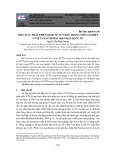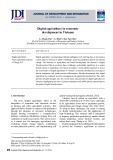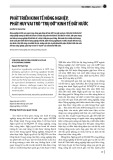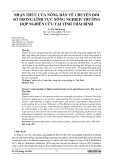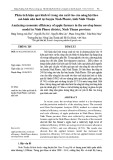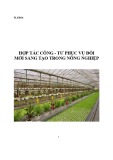
77
HNUE JOURNAL OF SCIENCE
Social Sciences 2024, Volume 69, Issue 4, pp. 77-85
This paper is available online at https://hnuejs.edu.vn/
DOI: 10.18173/2354-1067.2024-0069
EMERGING TRENDS IN GREEN AGRICULTURE RESEARCH:
A BIBLIOMETRIC ANALYSIS
Vu Dinh Hoa1 and Ngo Thi Hai Yen*2
1Faculty of Management and Creative Economics, Interdisciplinary Science and Arts School,
Vietnam National University, Hanoi city, Vietnam
2Faculty of Geography, Hanoi National University of Education, Hanoi city, Vietnam
*Corresponding author: Ngo Thi Hai Yen, e-mail: haiyen@hnue.edu.vn
Received November 10, 2024. Revised November 26, 2024. Accepted November 27, 2024.
Abstract. Green agriculture has gained significant attention in recent years, as evidenced by
a growing number of publications. However, comprehensive analyses of the field’s structure
and development remain scarce. This study addresses this gap by conducting a bibliometric
analysis using the Citespace tool, based on 295 articles indexed in the Scopus database from
2004 to October 2024. The analysis identifies trends in annual publications, leading journals,
and key research areas. Keyword co-occurrence analysis further reveals three primary
themes: the application of high-tech solutions to transform traditional agricultural models,
the alignment of agriculture with sustainable development, and the promotion of green
practices through advanced technologies. The findings also highlight gaps in the literature,
offering insightful directions for future green agriculture research.
Keywords: agriculture, green agriculture, bibliometric analysis, Citespace.
1. Introduction
In the context of climate change and global environmental degradation, traditional
agricultural practices, heavily reliant on natural resource exploitation and greenhouse gas
emissions, have posed significant challenges to both society and the environment. These
challenges necessitate rethinking conventional agricultural practices and proposing a shift
towards green agriculture (GA), a sustainable farming approach that integrates environmental
protection measures, minimizes emissions, and promotes ecological balance to enable agriculture
to adapt to adverse conditions [1, 2]. By safeguarding and improving natural resources, GA
emphasizes productivity, human health, and ecosystem preservation. Developing green
agriculture is not merely an option but an inevitable trend to ensure sustainable ecosystems, meet
the increasing demand for food, and safeguard the health and safety of future generations.
As of October 2024, the number of publications related to GA indexed in the Scopus database
has increased more than 60-fold compared to a decade ago, demonstrating a surge in academic
interest. Research in this field spans macro and micro levels. At the macro level, studies focus on
building sustainable agricultural systems to address climate change [3], adopting high-tech
applications to mitigate the environmental impacts of agricultural chemicals [4,5], and integrating
agriculture with green production strategies [6,7,8]. At the micro level, researchers develop
specific technologies and methods to reduce agriculture's environmental impact, protect

Vu DH & Ngo THY*
78
biodiversity, and improve ecosystem health. These efforts lay the foundation for sustainable green
agriculture that balances production needs with environmental preservation [9,10,11].
Bibliometric studies on GA primarily review specific topics using different approaches, such
as analyzing literature on new technology applications and identifying their potential in GA [12],
conducting systematic reviews on integrated pest management [13], and examining trends in the
application of organic fertilizers to support sustainable agricultural [14]. These studies continue
to propel the development of GA research.
Despite these advancements, new conceptual frameworks and ideas continuously emerge.
Therefore, quantitative bibliometric analysis is an appropriate method for researchers to track the
development of this trend, identify research gaps, and explore emerging areas. This study aims to
employ CiteSpace for bibliometric analysis on GA research to answer the following research
questions:
(i) What are the current research findings on GA?
(ii) What gaps remain to be explored further?
2. Content
2.1. Data and Research Tools
This study utilizes data from the Scopus database, a reputable and globally recognized
indexing system widely used in scientific research. Scopus ensures that the selected studies are
representative and of high academic quality [15]. To enhance the accuracy and reliability of the
analysis, the search process adhered to the PRISMA guidelines. The search employed the
keyword “green agriculture,” restricted to articles in English, yielding an initial dataset of 295
publications. These were subsequently screened based on titles and abstracts to ensure relevance,
resulting in a refined dataset for bibliometric analysis.
CiteSpace is a powerful bibliometric analysis tool, particularly renowned for identifying and
visualizing trends and patterns in scientific research [16]. Unlike other analytical tools, CiteSpace
not only aggregates data but also focuses on uncovering critical “breakthrough points” and
“research clusters” within a field [17]. One of its standout features is the ability to detect critical
nodes and edges within citation networks, facilitating the identification of influential authors,
articles, and concepts over time [18]. Additionally, CiteSpace enables users to pinpoint emerging
trends and potential “research gaps,” supporting the development of new research directions [19].
Through its visualizations and time-based analyses, CiteSpace provides researchers with quick
access to critical information, fostering a deeper understanding of the dynamic evolution of
research fields [18].
2.2. Research Findings
2.2.1. Annual Publications
Figure 1 illustrates the annual publication trends in GA research from January 2004 to
October 2024, with keywords related to GA first appearing in 2004. Overall, the development of
GA research can be categorized into three distinct phases:
(i) Initial Phase (2004–2017): This period marks the infancy of GA research, with an average
of only 1–3 publications per year. The limited output reflects the low awareness of GA concepts
and the absence of advanced relevant technologies. However, these early studies laid the
groundwork for future development;
(ii) Early Development Phase (2018–2020): During this phase, the number of publications
increased slightly and stabilized at over ten articles per year. This growth signifies the beginning
of intensified GA research, driven by increasing awareness of the impact of agriculture on climate
change and a growing global interest in sustainable agricultural practices;

Emerging trends in green agriculture research: a bibliometric analysis
79
(iii) Rapid Growth Phase (2021–2024): A notable surge in publications occurred during this
period, with the number of articles increasing from 30 in 2021 to 89 in 2023, representing a
threefold increase. By October 2024, 65 articles had been published, surpassing 54 articles in
2022, despite covering only part of the year. This growth highlights the global recognition of GA's
critical role in mitigating climate change, conserving soil resources, and ensuring food security.
These trends underscore GA’s emergence as a dynamic and rapidly expanding field of
research over the past decade, attracting increasing attention from researchers worldwide. As
such, contemporary scholars should continue to invest in and expand research in this promising
domain.
Figure 1. Annual number of published studies on GA
2.2.2. Journal Analysis Table 1. Publication journal statistics
Rank
Journal
5-Year IF
Count
1
Sustainability (Switzerland)
3.9
29
2
Journal of Cleaner Production
11.1
14
3
Environmental Science and Pollution Research
5.4
11
4
Agriculture (Switzerland)
2.8
8
5
International Journal of Environmental Research and Public
Health
4.5
8
6
Science of the Total Environment
8.2
8
7
Environment, Development and Sustainability
4.7
7
8
PLOS ONE
3.5
5
9
Scientific Reports
4.0
5
10
Frontiers in Microbiology
5.2
4
Table 1 presents the top 10 journals with the highest number of GA publications, highlighting
their significant contributions to this research field. The journals with the most publications
0001031031 1 43 3
12 10 16
30
54
89
65
0
10
20
30
40
50
60
70
80
90
100
200420052006200720082009201020112012201320142015201620172018201920202021202220232024

Vu DH & Ngo THY*
80
directly related to environmental science and sustainable development. Specifically,
Sustainability leads with 29 articles, followed by the Journal of Cleaner Production with 14
articles. While Sustainability is a multidisciplinary, open-access journal, the Journal of Cleaner
Production is a specialized subscription-based journal. Given their focus on environmental issues
and sustainability, it is unsurprising that these journals account for many articles in this field. The
two leading journals (Sustainability and Journal of Cleaner Production) represent over 14.6% of
total articles, while the remaining eight collectively contribute approximately 14.2%. Notably,
journals with high publication volumes typically exhibit high impact factors, with four journals
surpassing an impact factor of 5. The Journal of Cleaner Production stands out with an impact
factor exceeding 10, underscoring its significant influence in this domain.
These findings encourage researchers to improve their manuscripts’ quality and provide
guidance on selecting appropriate journals for future submissions.
2.2.3. Research areas related to green agriculture
Table 2 presents the top 10 fields contributing to research on GA which spans various
disciplines, including agriculture, environmental science, business, and social sciences. The most
prominent fields in GA research are environmental science (48.5%), agricultural and biological
sciences (26.8%), energy (18.6%), and social sciences (16.6%). Additionally, areas such as
computer science, chemistry, business and management, economics, pharmacology, and earth
sciences are also relevant. This highlights the interdisciplinary nature of GA research.
Table 2. Publication category statistics
Rank
Category
Count
Percent
1
Environmental Science
143
48,5
2
Agricultural and Biological Sciences
79
26,8
3
Energy
55
18,6
4
Social Sciences
49
16,6
5
Engineering
41
13,9
6
Computer Science
37
12,5
7
Chemistry
34
11,5
8
Business, Management and Accounting
25
8,5
9
Materials Science
24
8,1
10
Economics, Econometrics and Finance
21
7,1
2.2.4. Co-occurrence keyword analysis
Table 3 presents the ten most frequently co-occurring keywords in GA research: frequency,
centrality, and first appearance year. Overall, keywords such as “Green agriculture,”
“Agriculture,” and “Sustainable development” are the most frequently co-occurring, with
frequencies of 98, 85, and 30, respectively. These keywords strongly connect to green agriculture,
reflecting its focus on sustainability and agricultural practices.
Table 3. Top 10 co-occurring keywords
Ranking
Count
Centrality
Year
Keyword
1
98
0.11
2015
green agriculture
2
85
0.33
2015
agriculture
3
30
0.09
2010
sustainable development
4
26
0.12
2020
nonhuman

Emerging trends in green agriculture research: a bibliometric analysis
81
5
24
0.06
2018
fertilizers
6
22
0.05
2017
agriculture development
7
21
0.24
2012
alternative agriculture
8
19
0.08
2018
agriculture production
9
19
0.14
2019
chemistry
10
18
0.12
2021
soil
Figure 2 illustrates the temporal evolution of research keywords, tracing the development of
themes related to GA over time. The analysis reveals that research on green agriculture originated
from studies on general environmental protection, with “environmental protection” being the
prominent keyword before 2000 (The study expanded the search scope to identify keywords that
serve as the foundation for research on green agriculture, highlighting “environmental protection”
as a pivotal term and phrase first mentioned in the literature in 1990). During the 2000–2010
period, keywords such as “alternative agriculture” and “sustainable development” began to
emerge, marking a shift in focus towards sustainable development strategies and alternative
agricultural models. During the 2010–2020 period, more specific concepts, including “green
agriculture” and “agricultural development,” gained prominence, emphasizing sustainable
farming practices and the application of technology in agriculture. From 2020 to 2024, keywords
such as “green agricultures,” “chemistry,” and “alternative agriculture” became prominent,
accompanied by increasingly complex citation networks, reflecting the growing
interdisciplinarity in green agriculture research.
Figure. 2. Evolution of research keywords
Figure 3 illustrates the co-occurrence keyword clusters, encompassing 4396 nodes and 419
connections, covering a wide range of topics. This visualization reflects the diversity in
approaches and sustainable solutions within green agriculture and can be classified into three
primary research directions:




